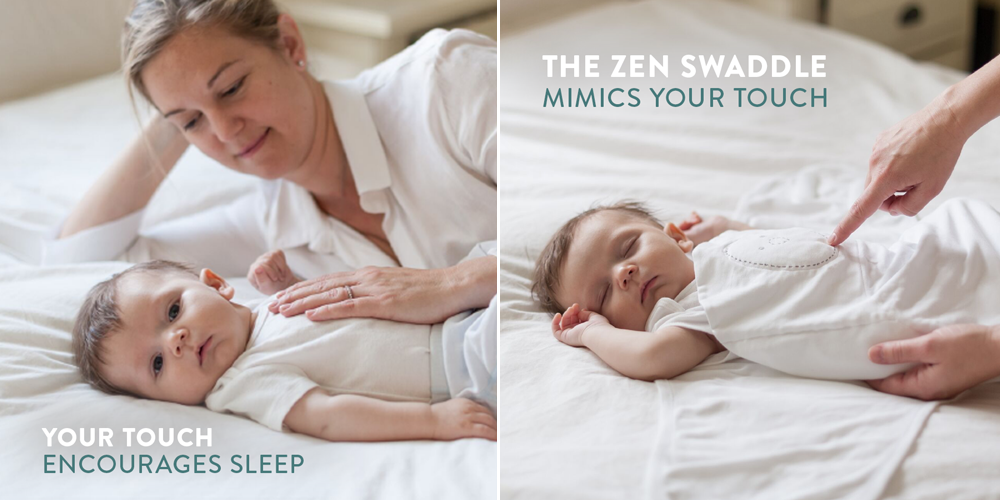Shopping Cart
You take your baby for the first pediatric evaluation and, among other things, your pediatrician will provide medical advice and check for the normal baby reflexes, such as tonic neck reflex, grasp reflex, sucking reflex, and rooting reflex.
This check includes looking for the presence of Moro reflex - an important indication of a normal and developing nervous system in your newborn. Everything is normal and you don't give baby's reflexes much thought - until Moro reflex starts waking up your baby and the troubles with sleeplessness begin.
In this article, you will learn:
5 Common triggers of Moro reflex
How to calm a baby experiencing Moro reflex
What the absence of Moro reflex means
What to expect after Moro Reflex
Identifying Moro reflex
All babies are born with a number of normal newborn reflexes. Moro reflex, also known as startle reflex, is one of these primitive reflex responses intended to keep baby safe. You may have noticed that your baby startles suddenly while sleeping before; this is the Moro reflex at work.
Moro reflex definition: a reflex reaction of infants upon being startled (as by a loud noise or a bright light) that is characterized by extension of the arms and legs away from the body and to the side and then by drawing them together as if in an embrace (Merriam-Webster).
When baby's Moro reflex occurs, they have a two phase reaction:
Phase 1 - The baby will experience what can be best described as a sensation of free-falling, where the baby reacts by lifting and stretching their arms. They may even let out a sharp gasp.
Phase 2 - Baby's arms and legs curl closer to their body into a slight fetal position.

There is no way to prevent Moro reflex from occurring - in fact, it's actually healthy for your baby to have this reflex, as it shows their little nervous system is properly developing. However, this can be particularly troublesome during sleep time, as it may wake your baby up from sound sleep.
Triggers of Moro reflex
This reflex is triggered by any sudden changes in sensual stimulation. There are many such triggers, but the common ones are:
1) A loud noise.
2) Sudden movements or a sudden touch.
3) An abrupt change in the intensity of light.
4) Any event that puts the baby off balance - such as a drop in altitude (when being placed into a crib, taken out of a bath tub for example).
5) A change in the direction of the baby's head or body.
Some of these triggers may be so minor, that you won't notice them. However, to your baby who, up until now, has been used to living in the womb, even the smallest of changes can evoke it.
How long does the Moro reflex last?
The reflex is most prominent in newborn babies, bu it gradually gets better and typically completely disappears by month 5 or 6. Typically by week-6 your baby's neck muscles get stronger and their overall balance and ability to support themselves starts to improve. This is the beginning of the improvement of Moro reflex.
AGES & STAGES OF MORO REFLEX
Birth-1 Month |
|
2-3 Months |
Your baby is calmer in your embrace. When awoken by the reflex, the gently weighted Zen Swaddle offers the security of your touch and soothes them back to sleep. |
4-6 Months |
Your baby is getting stronger. The reflex begins to improve and vanishes by 5-6 months. At this time check for these 6 signs on when to stop swaddling and how to transition into a sleeping bag. |
So to sum it up, Moro reflex starts at birth and ends at 4-6 months—around the same time when your baby starts is strong enough to roll over. You'll want to stop swaddling as soon as your baby starts showing signs of rolling over.
SO WHAT'S THE SOLUTION?...If such subtle changes in the babies environment trigger this reflex, what can you do to help your baby? Our solution? The Zen Swaddle® can help calm your baby when experiencing Moro Reflex. |
How to calm a baby experiencing Moro reflex
Your baby is still getting used to the outside world which is very different compared to the tight space inside the womb. So when experiencing Moro reflex, try drawing your baby's stretched arms and legs closer to their bodies and hold them in place until they calm down.
Your baby’s startle reflexes will begin to disappear as they grow. By the time your baby is 3 to 6 months old, they probably won’t demonstrate the Moro reflex any longer. They’ll have more control over their movements, and their reflexes will become less jerky.
You can help your baby progress by making time every day for movement. Give your baby space to stretch their arms and legs. This will help them tone and strengthen their muscles. Even newborn babies should have the opportunity to move, including their little heads. Just be careful to provide support to your baby’s head and neck when you’re holding them. - Healthline
A swaddle restricts the baby's movements and helps draw their extended limbs back, and also helps recreate the womb environment, which can help soothe babies while experiencing this startle reflex.
This is why swaddling is practiced around the world as a common way to calm infants. For those who may not know, a swaddle is a fabric that wraps around baby’s body like a cozy cocoon.
READ MORE MOM SUCCESS STORIES HERE |
Traditional swaddles are simple square blankets that require complicated tucking and folding to get a snug fit. The Zen Swaddle, however, uses secure fasteners for an easy, adjustable fit that won’t come loose, keeping your baby’s tiny limbs in place so they don’t startle awake.
Swaddling works best to calm Moro Reflex if it is introduced at birth. Consistently making swaddling part of your bedtime and/or naptime ritual early on will help create the association that once the swaddle is on, it’s time for sleep. Most babies are swaddled until 4 to 6 months old, so it remains an effective technique to calm Moro Reflex until it disappears.
ZEN SWADDLE®: HELPS CALM DURING MORO REFLEX1. Swaddle construction calms baby during Moro Reflex 2. Lightly weighted design helps self-soothe like your touch 3. Secure fasteners make swaddling easy and safe 4. Lasts 2x as long (2-pouch design adjusts from 0-6 months) 5. Hip healthy and eases colic |
Even when traditionally swaddled, it’s common for healthy babies to stir from Moro Reflex. He/she may cry out for you to hold the and soothe them back to sleep. Introducing self-soothing to your baby will help them learn to get back to sleep on their own, even after they experience an episode of Moro Reflex.
Because the Zen Swaddle is lightly weighted to mimic your gentle touch, its consistent use helps teach babies to self soothe as they get older. The added gentle pressure acts as your touch and helps keep baby calm, so even if they stir, they can fall right back asleep on their own.

To learn more about the other advantages of a swaddle for your baby, check out our Benefits of swaddling article. To see techniques on how to swaddle like a pro and keep baby safe while doing so with the super easy to use Zen Swaddle see this page on How to swaddle.
|
Zen Swaddle®: the perfect solution to sleeping through Moro Reflex. |
Why does the Moro reflex occur?
Would you believe that the Moro reflex is present to protect your newborn in these early stages of development? As a newborn is unaware of cause and effect yet, this reflex acts as an alarm that is triggered when a baby receives excessive or sudden information via the senses.
The first phase of the response (as described in the previous section) helps the baby react to an unpleasant stimuli. The second phase helps them cling to whatever is close, on many occasions their mother, as a way to protect themselves from falling.
FROM THE EXPERTS“Experts think that the Moro reflex evolved to keep babies closer to their caregivers, and to prevent falling. It’s absolutely normal for babies to exhibit the Moro Reflex. If your baby cries when startled, keep him more comfortable by swaddling or holding him close.” - Jennifer B. Lemoine, DNP, APRN, NNP-BC |
These two responses instinctively protect a child from whatever danger is associated with the stimulant. This is described in detail in this article. At birth all babies have a nervous system that is still developing. One sign of this development is that until 4 - 6 months of age infants startle easily as they experience a whole new world of sensations that were absent in the womb.
Absence of Moro Reflex: What it means
The absence of the Moro reflex, either on one or both sides, may signify problems in a baby’s nervous system. This can be checked and addressed by your pediatrician during scheduled visits. Should you see an absence of this reflex in between visits, you should bring it to your pediatrician’s attention immediately.
At birth your pediatrician checks for the Moro reflex among many other newborn reflexes your baby is born with. See how this reflex is checked in this article by MedilinePlus, a National HealthCare Library.
If you are curious about what other normal reflexes your developing baby is born with, visit this article by U.S. National Library of Medicine detailing the different types of newborn reflexes.
Does baby startle reflex while sleeping?
Babies shows some signs of startle reflex while sleeping as well. And to prevent baby startle reflex while sleeping make sure that the crib is away from any windows or doors where outside light or noise can come in and disturb your baby's sleep. You can also consider using a white noise machine or app to help soothe your baby and block out any other noise that might startle them
What to expect after the Moro reflex
While you’ll see Moro Reflex decrease from 4 to 6 months old, you’ll also notice your baby has more control over his/her movements and can roll over and back as they approach the 6 month mark. While you can continue to swaddle baby to help soothe them even after Moro Reflex ends, once your baby starts learning to roll over it is no longer safe to swaddle. This is the right time to start transitioning over to a sleeping bag. We recommend the Zen Sack™, because it’s gentle weight in the center helps to mimic your touch and gives extra comfort to a babe who is already used to the security of a swaddle.Take a look at the 6 signs of when to stop swaddling and check out our swaddle transition plan to help guide the way when the time comes!
You might also like...
Your Baby's Sleep Cycle Explained
How to Swaddle with the Zen Swaddle in 4-Easy Steps
When do Babies Sleep Through the Night and What Might Be Preventing It?
Common questions about the Moro reflex
When does the Moro reflex start?
The Moro reflex is present in all babies from birth, but probably begins in utero, as early as 25 weeks after conception.
When does the Moro reflex go away?
At the four-month mark, when a baby’s neck can support the weight of their head, the Moro reflex begins to disappear. Babies may not feel the sensation of ‘falling’, so their startle reflex becomes more infrequent and less jerky. They might only extend and curl the arms without moving the head or legs. The Moro reflex disappears completely when the baby is 6 months old.
Why do babies startle in their sleep?
Some babies startle for no apparent reason, but usually it’s in response to a loud sound, a sudden movement, intense light or the sensation of falling —like when you put your little one down in their crib. Babies can also trigger the Moro reflex themselves, when they move suddenly.
Why do babies have a startle reflex?
Many scientists believe the Moro reflex may have developed as a survival instinct to help babies cling to their mother. If the infant lost its balance, the reflex caused the infant to embrace its mother and regain its hold on the mother’s body.
When do babies stop flailing arms and legs?
When a baby experiences the Moro reflex, their body tightens, they fling their arms up and out and then draw up their knees suddenly. This response begins to subside between three or four months, and disappears completely after six months. Swaddling babies in the first few months can prevent Moro reflex by making baby feel more secure.
Why do babies get scared while sleeping?
The Moro reflex is an involuntary protective motor response common to all infants. It is not necessarily an indication of being scared; it happens when a baby is startled by a loud or unusual noise or if baby's head changes position or falls back abruptly.
When does startle reflex go away?
The startle reflex is a primitive reflex that is present at birth and typically disappears by 3-4 months of age. However, some infants may continue to exhibit the reflex into early childhood.
How to get baby to sleep through the night?
Try swaddling the baby. This is when you wrap the baby in a blanket so that it feels snug and secure and restricts the baby movements and help reduces startling. You can also try to keep your baby close to your body so your baby feels protected and reduce startling. You can also try to create a calming and relaxed environment for your baby before bedtime. This can help them feel more secure and less likely to be startled by the Moro reflex
Other Resources
Healthychildren.Org: Newborn Reflexes
American Academy of Family Physicians: Newborn with Abnormal Arm Posture






